CAUSES OF DEFECTS
Any speech disorder has its own reasons. Depending on age, several groups of causes are distinguished.
Causes of the disorder in adults:
- severe stress;
- damage to the speech apparatus;
- trauma of a psychological or physical nature;
- contusions;
- surgical intervention;
- infectious diseases;
- deafness.
In children, speech impediment occurs for the following reasons:
- severe fear or stress;
- injury;
- neurological disorders;
- dysfunction of the central nervous system or cerebral palsy;
- infectious diseases;
- incorrect formation or damage to the speech apparatus;
- heredity;
- deafness.
Conventionally, all causes are divided into two groups: physiological (associated with damage to the articulatory apparatus) and neurological (characterized by damage to the areas of the brain that are responsible for speech and a disorder of the nervous system).
Speech therapy speech disorders
The main form of speech correction is speech therapy classes. Before classes, the child is examined: his behavior in play, study, and communication with other people.
Speech disorders in a child negatively affect his emotional state. The child's interest in activities decreases and he withdraws into himself.
IMPORTANT: Parents must remember that they are responsible for their child. The sooner speech disorders are detected, the sooner you need to contact a specialist - a speech therapist.
Speech therapy speech defects in a child can be corrected through sessions with a specialist
TYPES OF SPEECH DEFECTS
There are several types of speech impairment. Some of them occur more often, and some occur in isolated cases, so working on them will be more difficult and longer.
Dislalia
One of the most common speech problems. A person with such a defect is characterized by a large vocabulary, the ability to construct and coordinate even complex long sentences, but at the same time may make mistakes in the pronunciation of individual sounds.
The defect belongs to the phonetic group (pronunciation is impaired). People with this disease do not have hearing problems.
Dysarthria
The disease is characterized by errors in the pronunciation of almost all sound groups. The cause of this problem lies in the disruption of the nerves connecting the speech apparatus and the nervous system. With this diagnosis, the work of such nerves is insufficient.
Dysarthria is characterized by the following features of human speech:
- incorrect intonation, rhythm and tempo of speech;
- slurred speech;
- problems with voice production.
Rhinolalia
The problem manifests itself in a violation of the timbre of a person’s voice. Remember how in childhood everyone tried to imitate an elephant (say “on the nose”). So in people with rhinolalia this happens involuntarily.
Nasal sound occurs due to anatomical disorders of the speech apparatus.
Stuttering
Characterized by disturbances in the rhythm, fluency and tempo of speech. Stuttering occurs due to spasms of the facial muscles and usually occurs from the age of two. The disease has the following features:
- sudden stop during a conversation;
- repetition of syllables or individual sounds;
- adding unnecessary sounds to words.
As the problem of stuttering occurs more and more often, it is important to know about the rules for preventing this disease. Moreover, you need to follow the recommendations constantly, and not just when the baby starts talking. That is, already at the time when the child is six months old, it is necessary to clearly monitor his own speech and manner of speaking. Everyone who surrounds the child must speak clearly, distinctly and understandably; in no case should you rush to swallow sounds and words. You should also adhere to the following recommendations:
- Avoid contact with people who stutter if possible.
- In front of a child, you should not make a scene or speak in a raised voice, much less shout.
- Avoid injury, especially to the head. It is important to ensure that the child does not receive psychological trauma.
- Do not overload your child with a lot of information and emotions, even positive ones.
- Do not try to make a child prodigy out of your child, do not overload him with activities.
- Avoid things that might frighten your child (movies or scary stories).
- Do not hit your child or choose to be alone in a dark room as punishment.
Alalia
Alalia is understood as the absence of speech in children from 3 to 5 years old. Absence can be partial or complete. The disease is caused by damage or underdevelopment of the area of the left hemisphere responsible for development. The developmental disorder or damage can occur in the womb or in the first months after birth.
There are two types of alalia. With motor alalia, the child understands everything, but cannot say anything on his own. And with sensory, there is a misunderstanding of the other’s speech. Often with this diagnosis, the child chaotically repeats sounds or entire words of an adult. Correcting the defect is difficult and time consuming.
Mutism
This disease most often develops as a result of severe psychological trauma. In children with this diagnosis, speech development stops, they completely stop speaking.
There is general mutism, in which the child completely stops speaking, and selective mutism, which manifests itself in the form of a protest against certain circumstances or the actions of others.
Childhood autism
The disease is characterized not only by the cessation of the child’s speech, but also by his immersion in experiences, detachment from everything that is happening around him and the people around him.
In autism, there is also a lack of everyday skills. Features of the disease are:
- increased excitability (in some cases even manifestation of aggression);
- fixation on one thing (the baby eats, drinks and plays with only one thing, and the selection criterion is most often the appearance of the object);
- reluctance to contact peers and adults, even parents;
- a highly developed sense of fear (and the child may not be afraid of the dark, but the sound of an alarm clock, for example, terrifies him).
General speech underdevelopment (GSD)
Typically, such a diagnosis is made when it is not possible to diagnose a specific problem. By general underdevelopment of speech, experts mean speech disorders that affect grammar, phonetics and vocabulary.
OHP is characterized by a child’s small vocabulary, his inability to construct sentences according to age standards, as well as impaired pronunciation.
OHP is also diagnosed if the baby begins to speak late (between the ages of 3 and 5 years), cannot inflect words and distinguish sounds.
Table of norms of speech skills by age
| Age | Speech skills, vocabulary |
| 1 year | 5-10 simple words denoting a loved one, object or action: mom, baba, bi-bi, give, bang, etc. |
| 2 years | 300-400 words, short sentences, use of verbs, adjectives. |
| 3 years | About 1500 words, use of the pronoun “I”, use of sentences of 3-4 words with the main parts of speech (verbs, adjectives, adverbs, etc.) |
| 4 years | 1500-2000 words, use of prepositions and conjunctions, temporal and spatial concepts. The softened pronunciation of consonants disappears. The child can pronounce hissing (Ш, Ш, etc.) and whistling (S) sounds. |
| 5 years | 2500-3000 words. The use of words is correct, without rearranging syllables and sounds. Using generalizing words (a skirt and a jacket are clothes, etc.) |
| 6-7 years | 3500 words. Figurative words and expressions are used (for example, “neither light nor dawn”), established phrases and sayings. A child can explain the meaning of a simple word and talk about its origin. |
If you liked the article, please share a link to it
SPEECH DEFECTS IN ADULTS
In adults, speech problems arise for two reasons:
- physiological (past illness, injury or concussion);
- psychological (fear, extreme anxiety or stress).
If the reasons are physiological, then you need to seek medical help (you will need surgery or the services of an otolaryngologist).
If you have psychological problems, you need to consult a psychiatrist or psychotherapist. However, do not forget about consulting a speech therapist or speech pathologist.
Impaired writing
For the first time, parents will realize that their child has problems with written language when teaching him or her to read and write.
Dysgraphia is an incomplete writing disorder that manifests itself in the repetition of the same mistakes when writing:
- replacing syllables or individual letters
- violation of the order of letters in words
- breaking individual words when writing them
Dyslexia is a partial reading disorder. Manifests itself in persistent errors caused by the absence of important mental functions.
Disorders of written speech appear when learning to write
SPEECH DEFECTS IN CHILDREN
It is believed that the peak activity of a child’s speech development occurs at 2.5-5 years. A normally developed child at the age of three should already be able to express himself in coherent sentences. A child should speak at least 5-10 words per year; by 4 years, the vocabulary should be at the level of 1000 words.
Up to 3 years of age, burr and lisp are not considered a speech defect and are explained by insufficient development of the articulatory apparatus (the tongue is most often located between the teeth when speaking). To eliminate these phenomena, parents are advised to carefully, unobtrusively correct errors in pronunciation, regularly pronounce words with errors, or work on individual sounds. If he hasn’t spoken before the age of three, he should be urgently shown to a specialist. Moreover, most likely, you will need the help of not only a defectologist, but also a neurologist.
We have already said that for proper speech development, adults must speak to the child clearly and intelligibly. Mangling words should not be encouraged, since over time such incorrect pronunciation will become a habit.
When is it time to sound the alarm?
By the age of 1 year, the baby should be able to pronounce from 5 to 10 words. If he talks less or doesn't talk at all, that's a red flag.
At 2 years old, children already communicate in simple phrases, use verbs, and their vocabulary is about 200-300 words.
At 3 years old, a child actively uses common phrases - for example: “Masha (has) a Dasha doll.”
It is worth consulting with a speech therapist if the baby still speaks in monosyllabic sentences. You should also contact a specialist if your baby pronounces sounds incorrectly. Another cause for concern is the absence of verbs in speech, the pronoun “I” and the incorrect order and forms of words in sentences.
At the age of 4, children pronounce the sounds Z and S well. They already know how to talk about events that have happened, ask questions and express their thoughts out loud. The children also use words in their speech that denote temporal and spatial concepts (close, far, soon, etc.)
Five-year-old children can pronounce the hissing words Ш, Ж, Ш. They use all parts of speech in sentences and use generalizing words (car, plane is transport, etc.). The children are able to pronounce words without omissions or substitutions of syllables and sounds.
At the age of 6, a child should learn to pronounce the letter P and speak fairly long phrases without mistakes. Children 6-7 years old can correctly use sayings, set expressions, and also explain the meaning of words.
If you have the slightest doubt about speech development, you should contact a speech therapist. The sooner you start acting, the faster you can correct the defect.
Teaching children with speech disorders
For children with speech disorders, comprehensive speech therapy work is provided.
Mandatory corrective measures:
- elimination of violations of oral and written speech
- elimination of mental development features
- vocational training.
IMPORTANT: The relationship between the work of speech therapists in kindergartens and schools plays a major role in preparing children with speech defects for education.
Teachers who have special knowledge and experience working with this category of children can significantly improve student results.
Teaching children with speech disorders
Severe speech impairment
The most severe speech disorders are alalia, aphasia, stuttering and various types of dysarthria.
They arise due to the influence of unfavorable internal and external factors.
Alcohol consumption, smoking by a pregnant woman, endocrine diseases of the expectant mother, toxicosis, incompatibility of the blood of mother and fetus lead to developmental disorders and the appearance of speech pathology.
Unfavorable conditions leading to severe speech disorders in children:
- stuttering may appear in a child whose relatives have a similar defect
- underdevelopment occurs in well-hearing children raised by deaf parents
Children with severe speech underdevelopment suffer from:
- memory disorders
- unstable attention
- deviations in the expression of emotions
Severe speech disorders in children can occur if the child is raised by deaf-mute parents.
Following the clear instructions of the speech therapist, following all the specialist’s recommendations, regularity of classes, and, of course, the persistence and patience of the parents - all this together will lead to the necessary result in the formation of correct speech in children. child.
Speech disorders in preschool children
The main speech disorders in preschool children are mutism, alalia and stuttering.
IMPORTANT: Identified speech disorders in preschool children require immediate correction.
If parents do not take all the necessary measures in time to normalize the speech of a preschool child, he will experience difficulties in learning and communication during his school years. In severe cases, speech defects cause the child to refuse oral reading.
Speech impairment in preschoolers requires immediate correction
Games for children with speech disorders
Playing games with a child with speech impairment should be accompanied by emotional movements and the demonstration of bright pictures. This will relieve the burden, improve the quality of knowledge acquisition, and push the child to speech activity.
"Magic bells" The teacher invites the children to listen to the sounds made by the ringing bells. When they ring quietly, the children sit on chairs; when they ring loudly, they run around the classroom.
"Smart ball" If the teacher throws a red ball, then, having caught it, the child names any word with a hard sound. If the teacher throws a yellow ball, the baby pronounces the word with a soft sound.
Pure talk. Children are asked to repeat after the teacher or come up with rhymes on their own, for example: “Sa-sa-sa, where is the wasp sitting?”, “For-for-for, the goat will come running.”
IMPORTANT: The effect of any speech therapy game will be higher, the more the child is involved in it and interested in the process.
Games for children with speech disorders



